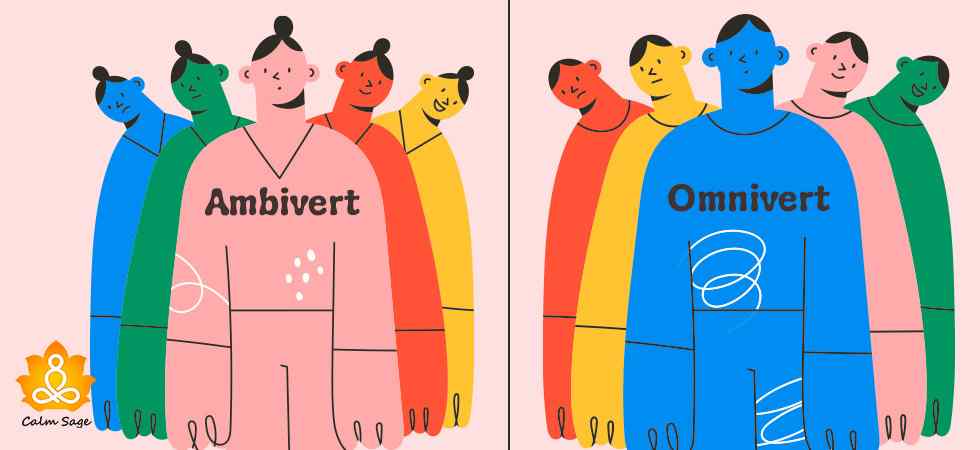Ambivert vs. Omnivert: What’s The Difference Between Them?

Things You Should Know
|
I’ve often considered myself an introvert, but lately, I’ve come to realize that other terms or personality types can define me better than an introvert. I’m sure you know about introvert or extrovert personality types by now, but what about ambivert or omnivert? Do you know that ambiverts and omniverts are personality types that exist on the spectrum of introversion and extroversion?
I didn’t! So, I dug up some interesting facts about ambiverts and omniverts that I think everyone should know about. Understanding these two personality types can be a bit tricky but bear with me, will you?
In this article today, I’ve gathered some key differences between ambiverts and omniverts that will help you understand these two personalities better. And who knows, maybe at the end of this article, you’ll be able to define your personality traits better!
Before we look at the differences between an ambivert and an omnivert, let’s take a look at what these personality types are.
What are Ambiverts?

When we talk about the differences between ambiverts and omniverts, it’s important to first understand what are these two personality types. For one, ambiversion means “two of a pair” so this means that an ambivert is someone who exists between introvert and extrovert. They are neither but lie somewhere in between.
Ambiverts are comfortable with social situations but they’re also comfortable with themselves, alone. They can hang out with their loved ones but also crave alone time now and then. Ambiverts are all about balancing extroversion and introversion.
Signs of Ambivert
Below listed are some of the common signs of ambiverts:
- Good listening skills
- Great communication skills
- Ability to regulate or control behavior
- Feel comfortable in alone time and social settings as well
- Great empathy
- Ability to provide balance to the dynamics
Examples of Ambivert
Ambiverts have excellent communication skills with perception. They know when to listen, speak, or acknowledge. These people also have great judgment power. Additionally, they know how to balance the right energy when surrounded by extroverts or introverts. They are both rational and emotional thinkers. They can maintain their sense in social settings and solitude. That is why, you will often find ambiverts having deep and meaningful relationships with their loved ones.
What are Omniverts?

Talking about omni-, means “universal” so an omnivert is someone who can be both extroverted and introverted, mostly depending on the social requirements. Omniverts can hop from one personality to another quite easily.
Omniverts are social and quiet, shy but also adventurous. Hanging out with this personality type can give you social whiplash because they are unpredictable and you never know which personality trait they’ll come up with in the next social gathering.
Signs of Omnivert
Below are some of the common signs of omniverts:
- Love socializing with people but not everyone
- Love maintaining a conversation but can easily dose off in the mid-way
- Backs out from the plans when not interested
- Enjoys more with extroverts and feels low with introverts
- Good listening skills
- Different scores on the personality test every time
- Love and hate maintain the limelight
- Extreme mood swings
Examples of Omnivert
People with omnivert personalities love meeting new people, they can be extremely social and talkative sometimes. In some situations, you might find them avoiding people because of less engagement. An omnivert personality always reads a social situation to maintain their sense. This can make them look sometimes moody as well. An omnivert also needs to spend some alone time to recharge and engage with others to gain energy.
Ambiverts vs. Omniverts: The Differences…

When you don’t exactly fit in with introverts or extroverts, it leaves you wondering, “Who am I?” “Am I being ambivert?” or “Am I an omnivert?” These key differences between ambiverts and omniverts might help you find your place in social circles.
I hope that by the end of this article, you’ll be better able to get a clear picture of who you are;
1.Always in Between Hopping Between Each
The first major difference between ambiverts and omniverts is that ambiverts are always in between extroverts and introverts. They are neither here nor there. Their personality has both introvert and extrovert traits that allow them to be careful and confident in social interactions. They might not be ready to mingle with everyone but they can be comfortable in a group.
Omniverts, on the other hand, exist either here or there. They hop from extrovert to introvert, depending on the situation they are in.
2.External Extroversion vs. Internal Extroversion
Ambiverts are a mix of introverts and extroverts, but their extroversion comes from external stimulation. They adapt to their personality traits depending on the social requirements, however, omniverts are different in this aspect.
An omnivert’s extroversion is internal. Or more like, their extroversion depends on their internal stimuli. For example, if they need to be in a huge group of people, they will bring out their extrovert side proudly, but if they decide to spend time alone, they will choose to be more introverted.
3.In the Moment vs. Balance
Another key difference between ambiverts and omniverts is that ambiverts can be either introverts or extroverts depending on the moment whereas omniverts are more blanched in their personality traits.
How? Well, if an omnivert chooses to be an extrovert, they will be undeniably extroverted – there will be no confusion. Ambiverts don’t have modes and can shift their personality traits depending on the moment.
4.Hybrid Personality vs. Varied Personality
Ambiverts have a hybrid personality where they can identify with both Introversion and Extroversion, however, omniverts have varied personalities, meaning that their personality types may change from one day to the next.
For example, let’s take the MBTI test. If your MBTI type is either ENTP or INTP, you may identify with either of the I-leading or E-leading types, making you an ambivert, but if your MBTI type changes from one day to the next, for instance, today your MBTI says INTP and tomorrow the result is ENTP, then you may be an omnivert. This means that some days you are more I-leading personality and some days more E-leading type. Never both.
5.Emotional Stability vs. Emotional Adjustability
Ambiverts have emotional stability and have a healthy balance between extroversion and introversion, however, when we talk about omniverts, they show a lot of emotional adjustability, meaning that they react depending on their social energy.
An ambivert’s social skills might not be adjustable as an omniverts and they need time to recharge. Omniverts are more evident with their “recharge time” than ambiverts.
6.Balanced vs. Imbalanced
If you identify with the ambivert traits then you’re likely to show neither too much of an introvert side nor too much extrovert side. There is a subtle balance between introversion and extroversion when you’re an ambivert. However, if you’re an omnivert then you’re likely to be more misunderstood because of the imbalance in extroversion and introversion.
Omniverts are unpredictable and you never know which side they’ll be on today so it makes them a little more imbalanced than ambiverts. With ambiverts, it’s clear that they’ll be somewhere in between.
7.Socially Stable vs. Socially Flexible
Last but not least, ambiverts neither seek nor avoid social gatherings. However, whenever they choose to socialize, their social company consists of the same group of people, making them socially stable too. Omniverts, on the other hand, are socially flexible, meaning that their choice of a social company may depend on their social energy and environment.
For example, if an omnivert is in extrovert mode, then they’ll hang out with other extroverts, and if they are in the introvert mode, they would seek their own company or with other introverts.
Understanding the Differences: Ambivert Vs. Omnivert Vs. Extrovert
| Ambivert | Extrovert | Omnivert |
| Exhibits a balance of extroverted and introverted traits. | Exhibits totally outgoing personality and is the center of the party | Easily switches between being an introvert and extrovert depending on the mood, will, and context |
| Comfortable in social settings, outgoing, and can also enjoy alone time to recharge themselves | Outgoing, action-oriented, energetic, spontaneous, optimistic, and talkative personality | Keeps more control of their social engagement and generally adjusts them according to the mood |
| Knows how to balance between outgoing and reflective | Thrives in crowds and is keen to learn more about people and the world
|
Feels immensely extroverted or introverted in situations according to their situations |
Are You Ambivert or Omnivert?
Now that you know the difference between an ambivert and an omniverts, you’ll be able to better understand which side of personality you belong to. Before you come to your conclusions, it’s important to understand that neither of these personality types is inferior or superior to the other, even though each may have its strengths and weaknesses.
The more you know about your personality type, the more you know about where you belong in social circles. While ambivert and omnivert might seem a lot similar to each other, there are subtle differences between them that you should know.
Frequently Asked Questions
I hope this blog helped you understand the differences between Ambiverts vs. Omniverts and where they diverge from introverts and extroverts. If you’re an ambivert or an omnivert, let us know in the comments below.
For more, you can write to us at info@calmsage.com or DM us on social media.
Take Care!




















